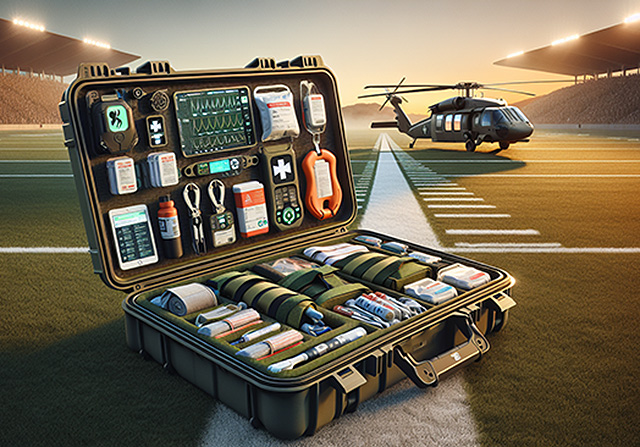Imagine you're cheering on your favorite team under the bright lights at a local football game. The energy is electric, the crowd is buzzing, and athletes are giving their all. In a split second, the unexpected happens: a player goes down, and it's clear they're hurt badly. This is where the game changes, not just on the field but off it as well.
A quick medical response can differentiate between minor injuries and life-threatening situations. The key to this swift action? The advanced medical supplies on hand, some of which have their roots deep in military history. You can find more info here on how these medical innovations have transitioned from the battlefield to the playing field. Nevertheless, keep reading if you want some further insights into the evolution of emergency medical supplies in the sports realm.
 an emergency medical kit
an emergency medical kit The crucial role of emergency medical supplies in sports injuries
High-contact sports like football, rugby, and hockey can sometimes result in severe injuries, making the presence of emergency medical supplies non-negotiable. Take a tourniquet, a device designed to stop heavy bleeding by tightly constricting blood flow to a limb. Originally developed for battlefield injuries, it's now a staple in sports first aid kits. A study shared compelling evidence of a soccer player who suffered a life-threatening cut during a game. The quick application of a tourniquet by the onsite medical team controlled the bleeding until emergency services arrived, saving the player's life. This underscores the undeniable importance of having emergency medical supplies close at hand during athletic events.
Furthermore, the accessibility of emergency medical supplies has evolved. Once rare and complex, automated External Defibrillators (AEDs) are now user-friendly and present at most sporting venues. In the event of a cardiac arrest, which can be caused by a direct hit to the chest or underlying health conditions, AEDs become lifesaving apparatuses. Their introduction into sports medicine, with clear, simple instructions, means that even laypersons in the vicinity can offer crucial help before professional medical help arrives.
Innovations in medical gear are changing the game for athlete safety
The transition of military-grade technology to the sports world isn't just happening; it's revolutionizing how we approach athlete safety. Modern tourniquets now include features like pressure gauges and quick-release mechanisms, allowing for rapid but controlled application. Then there are chest seals, designed for gunshot or shrapnel wounds, which are now being utilized to manage severe chest injuries on the field. Innovations don't stop there; the concept of "wearable" emergency supplies, like integrated tourniquet systems in uniforms that can be activated in seconds, is progressing from idea to reality. This blend of military precision and medical necessity is paving the way for a new era of sports safety gear.
Advanced hemostatic agents, another military innovation initially used to control severe bleeding in combat wounds, have also found their way into sports medicine. Composed of substances that accelerate the body's natural clotting process, these agents can be directly applied to wounds during a game to stem bleeding rapidly. This kind of quick intervention is particularly advantageous in sports with high risks of cuts and lacerations, making the transition from military use to athletic emergencies a perfect example of cross-disciplinary innovation.
How to be prepared for an unexpected medical emergency during sports events
Preparation is crucial; having a well-stocked medical kit is just the start. These kits should include traditional supplies like bandages and ice packs and advanced equipment such as tourniquets, chest seals, and splints. Regular, hands-on training sessions ensure that everyone, from coaches to players, knows how to use these emergency supplies effectively. A key strategy is the "two-minute drill" — a practice where teams simulate a medical emergency to improve their response time and familiarity with medical equipment. Also, having an established plan for immediate coordination with medical personnel can streamline the emergency response, making those critical first minutes more efficient.
The intersection of military-grade medical supplies and sports medicine
Adapting military-grade medical supplies for sports use is a testament to human ingenuity and the continuous quest for safety. These supplies, built for durability and designed to save lives in the most challenging conditions, now serve athletes on the field. The shift is not just in the tools themselves but in the mindset; safety protocols now emphasize prevention and preparedness.
This integration of military and sports medicine represents a significant leap forward in protecting athletes, ensuring that they have the same level of immediate care on the field as our soldiers do on the battlefield. As this evolution continues, we can expect to see even more advanced, life-saving technologies becoming standard fixtures in every sports team's medical kit.
Related Pages
- Sport specific injury treatment and prevention
- Essential Items for a Sports First Aid Kit
- What is R.I.C.E. and why do you need it?
- No HARM Principle — complementing RICE.
- Treatment of injuries and other medical conditions
- Functional Movement Screening — accessing movement patterns and identifying deficiencies that may increase injury risk.
Disclaimer


 Current Events
Current Events